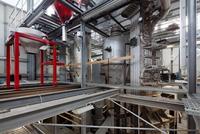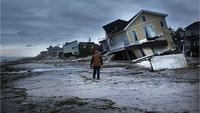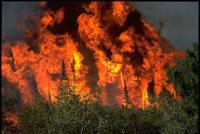-
Americans support preparation for extreme weather, coastal challenges: survey
The challenges posed by rising sea levels and increasingly severe storms will only intensify as more Americans build along the coasts. A just-released NOAA report predicts that already crowded U.S. coastlines will become home to an additional eleven million people by 2020. A Stanford survey finds that the majority of Americans support stronger coastal development codes. Among the most popular policy solutions: stronger building codes for new structures along the coast to minimize damage, and preventing new buildings from being built near the coast.
-
-
Genetically engineered multi-toxin crops make insects insecticide-resistant
The popular new strategy of planting genetically engineered crops that make two or more toxins to fend off insect pests rests on assumptions that do not always apply, researchers have discovered. Their study helps explain why one major pest is evolving resistance much faster than predicted and offers ideas for more sustainable pest control.
-
-
Using waste heat to capture CO2 before it goes up in smoke

Power plants fired by coal and natural gas account for about half of the CO2 that humans add to the atmosphere each year; these power plants are prime candidates for new technology that captures CO2 before it goes up in smoke. Researchers seek to optimize CO2 removal from power plant emissions by employing waste heat. This is just one example of looking to improve upon a tried-and-true technology for CO2 capture. That technology — a two-phase chemical process — has been used for decades to remove naturally occurring CO2 from natural gas.
-
-
U.S. suffered $119 billion in disaster-related losses in 2012

Natural and man-made disasters contributed to $186 billion in economic losses around the world last year. The United States took the biggest hit with $119 billion in losses. Insurance claims for weather-related losses in 2012 totaled $77 billion dollars, the third most expensive losses on record. Nine of the top ten most expensive insured loss events which occurred last year happened in the United States.
-
-
Suppressing naturally occurring blazes increases wildfire risk

According to the National Interagency Fire Center, 9.3 million U.S. acres burned in wildfires in 2012 compared with 3.57 million acres affected in 2001 and 2.95 million in 1991. One reason for the increase in the number of acres consumed by wildfires is the U.S. government’s policy of suppressing of naturally occurring blazes. Researchers say that this policy can have unintended consequences, including making wildfires more severe.
-
-
More than 10,000 pesticides approved by EPA without rigorous review
Congress allowed the Environmental Protection Agency (EPA) to use what is called “conditional registration” to approve pesticides deemed especially beneficial for food production – even before all the toxicity tests have been completed. Congress intended conditional registration to be used only sparingly, but the EPS has been using the loophole in a wholesale fashion to approve 65 percent – or more than 10,000 – of the 16,000 pesticides submitted to it for approval. The EPA cannot easily track the history of conditionally approved pesticides to determine whether required toxicity data was submitted, whether that caused a dangerous use of a pesticide to be cancelled, or whether the uses or restrictions should be modified based in such data.
-
-
Focusing on climate’s impact on fisheries leads to misguided conclusions
In the early 1940s, California fishermen hauled in a historic bounty of sardine at a time that set the backdrop for John Steinbeck’s novel Cannery Row. By the end of the decade, however, the nets came up empty and the fishery collapsed. Where did they all go? A new study argues that the problem in seeking answers to this – and similar – questions lies in the fact that researchers typically try to find the answers by focusing on one factor at a time. What is the impact of climate on sardines? What is the effect of overfishing on sardines? Focusing on single variables in isolation can lead to misguided conclusions, the authors of the study say. The authors argue that climate, human actions, and ecosystem fluctuations combine to influence sardine and other species populations, and therefore such factors should not be evaluated independently.
-
-
Understanding the threat of invasive species

Catching rides on cargo ships and fishing boats, many invasive species are now covering the U.S. shorelines and compromising the existence of American native marine life. Once invasive species arrive in their new location, they begin multiplying, and in some cases, overpowering the local marine life.Researchers examine what factors allow some invasive species to survive in their new environments and others to fail.
-
-
NOAA predicts drought, flooding, warm weather for spring
The U.S. National Oceanic and Atmospheric Agency (NOAA) yesterday issued the three-month U.S. Spring Outlook, saying Americans should brace themselves for the following: above-average temperatures across much of the continental United States, including drought-stricken areas of Texas, the Southwest, and the Great Plains. These areas, and Florida, will see little drought relief owing to below- average spring precipitation. River flooding is likely to be worse than last year across the country.
-
-
Improved weather, climate predictions strengthen the U.S. economy
The economic costs of damaging weather events have an immense and increasing impact on the U.S. economy. These costs could be anticipated and mitigated by improved weather and climate predictions, say a range of experts in the public and private sectors. These experts will meet in early April in an American Meteorological Society event to discuss the economic benefits of how environmental forecast, prediction, and observation programs and services strengthen the U.S. economy.
-
-
New technology for carbon-dioxide capture, clean coal reaches milestone

An innovative new process which releases the energy in coal without burning — while capturing carbon dioxide, the major greenhouse gas — has passed a milestone on the route to possible commercial use.
-
-
Loss of summer rains lead to long droughts in southwest U.S.
Long-term droughts in southwestern North America often mean failure of both winter and summer rains, according to new research. The finding contradicts a commonly held belief regarding the region — that a dry winter rainy season is generally followed by a wet summer season, and vice versa. In fact, when severe, decades-long droughts have struck the area in centuries past, both winter and summer rains generally were sparse year after year.
-
-
Does warmer climate mean stormier, or only wetter, weather?
Many scientists argue that the climate has warmed since people began to release massive amounts greenhouse gases to the atmosphere during the Industrial Revolution. These scientists, however, are less sure that warming climate creates stormier weather. The reason: nobody has done the quantitative analysis needed to show this is indeed happening. Until now.
-
-
Petroleum use, greenhouse gas emissions of U.S. automobiles could drop 80 percent by 2050
A new National Research Council study finds that by the year 2050, the United States may be able to reduce petroleum consumption and greenhouse gas emissions by 80 percent for light-duty vehicles — cars and small trucks — via a combination of more efficient vehicles; the use of alternative fuels like biofuels, electricity, and hydrogen; and strong government policies to overcome high costs and influence consumer choices.
-
-
“Dirty blizzard” accounts for missing Deepwater Horizon oil
The Deepwater Horizon disaster spilled more than 200 million gallons of oil into the Gulf of Mexico. Microbes likely processed most of the oil within months of the spill, but these microbes do not account for all of the spilled oil. Scientists have now found what happened to the oil not processed by microbes: the oil acted as a catalyst for plankton and other surface materials to clump together and fall to the sea floor in a massive sedimentation event that researchers are calling a “dirty blizzard.” The oily sediments deposited on the sea floor could cause significant damage to ecosystems and may affect commercial fisheries in the future.
-
- All
- Regional
- Water
- Biometrics
- Borders/Immig
- Business
- Cybersecurity
- Detection
- Disasters
- Government
- Infrastructure
- International
- Public health
- Public Safety
- Communication interoperabillity
- Emergency services
- Emergency medical services
- Fire
- First response
- IEDs
- Law Enforcement
- Law Enforcement Technology
- Military technology
- Nonlethal weapons
- Nuclear weapons
- Personal protection equipment
- Police
- Notification /alert systems
- Situational awareness
- Weapons systems
- Sci-Tech
- Sector Reports
- Surveillance
- Transportation
Advertising & Marketing: advertise@newswirepubs.com
Editorial: editor@newswirepubs.com
General: info@newswirepubs.com
2010-2011 © News Wire Publications, LLC News Wire Publications, LLC
220 Old Country Road | Suite 200 | Mineola | New York | 11501
Permissions and Policies
Editorial: editor@newswirepubs.com
General: info@newswirepubs.com
2010-2011 © News Wire Publications, LLC News Wire Publications, LLC
220 Old Country Road | Suite 200 | Mineola | New York | 11501
Permissions and Policies
